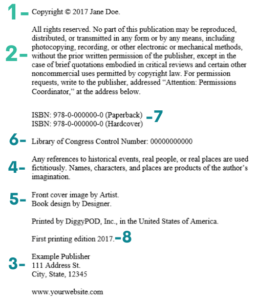Creating your eBook copyright page can be a confusing and daunting task if you are unsure of where to start. Here, we’ll break down the copyright page into the necessary elements authors need to help protect their rights.
There are essentially two types of eBook copyright pages: an abridged page with the bare necessities, and an unabridged page that has the bare necessities plus additional information.
Unabridged copyright pages include elements such as a disclaimer, edition numbers, printing numbers, publisher information, and a CIP Data block if you are obtaining a CIP (Cataloging in Publication) record.
Let’s start with the basics.
- 1. Copyright Notice
- 2. Reservation of Rights
- 3. Publisher’s Name & Contact
- 4. Disclaimer Statement
- 5. Credits
- 6. Library of Congress Cataloging-in-Publication Data
- 7. ISBN
- 8. Editions, Print Numbers and Trademark Notices
Where Does the eBook Copyright Page Go?
Within the frontmatter of your book–these are the pages before you get to the actual story of the book–there are 4 major parts: the half tite, the title page, copyright page, and the second half title page. There are many other pages that can appear between the copyright page and the half title page, but the thing to focus on is that the copyright page most typically comes after the title page.
Now that we know where the copyright page goes, let’s take a look at what goes onto the page. In the abridged version of a copyright page, there are two essential items:
1. The Copyright Notice
Copyright Notice – Registering Your Copyright
The Copyright notice is that familiar little © symbol we are all used to seeing at the beginning of a book. Essentially, it is a formality. You technically own the rights to your book as soon as you have created it! However, registering your book with the U.S. Copyright Office and having the copyright symbol on your eBook Copyright page serves to make it a matter of public record that you are the copyright holder.
Why is this public record important? Having a registered copyright with the U.S. Copyright office helps your case if you bring a lawsuit in the event you believe someone has plagiarized your book.
So how do you register your copyright? When you visit the U.S. Copyright Office’s Registration page, there is a disclaimer at the top that gives you a brief rundown, and includes an instruction video on how to complete the copyright registration application.
There are two ways to file your application–electronic and hardcopy–with electronic being the preferred method. The filing fee to register one work with only one author/claimant is $35. This fee is subject to change, so be sure to check the U.S. Copyright Office for the current fee amount.
Copyright Notice – Where Does It Go and What Does It Look Like?
The copyright notice is typically the first thing to appear on the copyright page. The notice itself consists of:
The copyright
The name of the copyright holder
The book’s publication date
The copyright can be depicted in one of three ways:
The symbol: ©
The word: Copyright
The abbreviation: Copr
Your final product will look like this: © John Smith 2019
2. Reservation of Rights – The Short and the Long
The Reservation of Rights is just like it sounds; it is the statement that announces that the rights belong to the copyright holder.
The short version can be this and this alone:
All Rights Reserved.
The long version goes into a little more depth about what rights are held and who to contact for more information or to request rights. This statement looks like this:
All rights reserved. This book or parts thereof may not be reproduced in any form, stored in any retrieval system, or transmitted in any form by any means—electronic, mechanical, photocopy, recording, or otherwise—without prior written permission of the publisher, except as provided by United States of America copyright law. For permission requests write to the publisher, addressed “Attention: Permissions Coordinator,” at the address below.
Although the above language is standard legal boilerplate for a Reservation of Rights, there may be amendments that need to be made based on your specific book. Be sure to read it carefully and change or add anything relevant to your book. For instance, you may want a Reservation of Rights that looks something more like this:
All rights reserved. No part of this book may be reproduced or used in any manner without written permission of the copyright owner except for the use of quotations in a book review. For more information, address: – Reedsy
Now that you have your copyright notice and your Reservation of Rights statement, you are technically all set. But what if you have publisher information to include? What if you want a disclaimer statement?
The Copyright Page Bells and Whistles
3. Publisher’s Name & Contact
If you have a publisher, or you yourself are the publisher and want be contacted as such, this information will go beneath your Reservation of Rights statement. Here you should include:
- Name of the publisher
- Street address
- Website and/or email address
4. The Disclaimer Statement
More and more often, authors are choosing to include a disclaimer statement about their work as en extra CYA. Disclaimers typically either come before the copyright notice or right after the publisher’s name and contact information.
These statements look different for fiction, nonfiction, and biography/memoir, but they all serve to do the same thing: help protect authors in the event of a lawsuit. Here’s what they tend to look like:
Fiction: This is a work of fiction. Names, characters, places, and incidents either are the product of the author’s imagination or are used fictitiously. Any resemblance to actual persons, living or dead, events, or locales is entirely coincidental.
Nonfiction: This is a work of creative nonfiction. Some parts have been fictionalized in varying degrees, for various purposes.
Biography/Memoir: The events and conversations in this book have been set down to the best of the author’s ability, although some names and details have been changed to protect the privacy of individuals.
These are all standard, legally protecting statements, however, you can get fun and creative with them, and doing so is often a way to get more specific to the contents of your book and therefore provide better protection. You can check out some great examples from Helen Sedwick here.
5. Credits
Next, you may have people to credit for their work related to your book. This may be the cover designer, overall book designer, images or photography included, etc. These credits are very brief statements such as:
Designed by: John Smith
Cover design by: Jane Smith
Jacket photography by: Photographer Name
6. Library of Congress Cataloging-in-Publication Data
The CIP data block typically comes after the credits and is perhaps the most confusing aspect of the unabridged copyright page, at least until you know what you’re looking at. For the most part, as a self-published author, you won’t need to include this, but it doesn’t hurt to know what it’s all about.
The CIP data block is a bibliographic record prepared, most often, by the Library of Congress. The Library of Congress generally limits cataloging services to publishers that produce 5 or more titles a year, however, there are other CIP data block providers you can pay to generate this block for you. These blocks are technically called, PCIP data (Publisher’s CIP).
If, as a self publisher, you are interested in having this data on your eBook copyright page, the Library of Congress now provides Preassigned Control Numbers (PCN) for those authors and publishers which are not producing high volumes of work each year. This number can be obtained online from the Library of Congress here.
Both the CIP data block and a PCN is used to facilitate processing of the book used by libraries and book distributors once a book has been published.
7. ISBN
Within the CIP data, the ISBN is listed. If you do not have a CIP data block, but you do have an ISBN, you will still want to list it. This can live on its own beneath the credits, and will look like this:
ISBN 000-0-0000-0000-0
So what is an ISBN? The ISBN, or International Standard Book Number, is a unique number generated and attributed to your book for commercial sale purposes. Not every book will have or need an ISBN to be sold, however, it is a good idea to have one. Having an ISBN helps make marketing, distributing and discovering your book easier!
An ISBN in the US can be obtained here.
Currently, here are what the top book retailers say about needing an ISBN to list your book through them:
- eBooks with Amazon KDP: No
- eBooks with Barnes & Noble: Yes
- eBooks with Kobo: No
- eBooks with Apple: No
- eBooks with Google Play: No
8. Editions, Print Numbers and Trademark Notices
Chances are, as a self-published author, you won’t have much of this information, if any, to add to your copyright page, but it doesn’t hurt to know what this is in case it becomes relevant to you.
Edition – this is simply a descriptor of which edition the book is. You can also include the date of the edition if you’d like. This can be as simple as writing:
First Edition
Print Numbers – these are the string of numbers at the bottom of the copyright page that you will sometimes see. The numbers are used to denote how many printings the book has undergone. The lowest number you see in the list is the printing number of the book you have. The printing numbers will most often will look a line of descending numbers, like so:
10 9 8 7 6 5 4 3 2 1
Trademark Notices – this is a notice stating any trademarks you or the publisher may hold to any logos or names used in the book. Most often, this is a publisher’s trademark notice to the name and or logo of the publishing company or imprint company listed on the book.
Copyright Page Conclusion
While there are many bells and whistles you can add to your eBook copyright page, the two essential pieces are the copyright notice and the Reservation of Rights statement. And remember not to sweat it too much, you hold the copyright as soon as your book is created, but having an official copyright page can go a long way in protecting you and your material!

